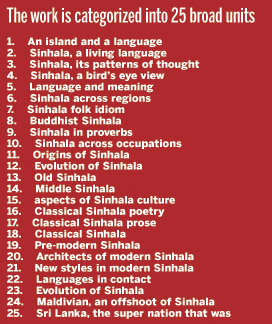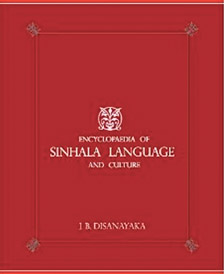An unconventional encyclopedia
 We need the works titled as ‘encyclopedia’ to gather knowledge on
various subjects. Some of these works are alphabetically arranged. Some
works look more like dictionaries, which are denoted by terms such as
glossary and thesaurus. We need the works titled as ‘encyclopedia’ to gather knowledge on
various subjects. Some of these works are alphabetically arranged. Some
works look more like dictionaries, which are denoted by terms such as
glossary and thesaurus.
By and large, the compilation of encyclopedia has changed its
conventional meaning through the concept of knowledge seeking has not
been undermined. This is one central factor I gathered while reading the
latest contribution of our friend Professor J B Disanayaka, broadly
titled as ‘Encyclopedia of Sinhala Language and Culture’.
As J B motions in his preface, this is a book of an unusual kind. He
adds that in a sense it is an encyclopedia but an encyclopedia of a
different kind. This is further clarified when he states that it differs
from a traditional encyclopedia in four basic ways. They are denoted as
presentation of fact, not alphabetically but thematically. The second is
that the themes do not cover all aspects of knowledge but only those
related to Sinhala, the language and culture in which it is embedded.
The third is that all contributions are by the same author. Finally
there is an underlying theme that brings all the essays together. The
compiler Disanayaka takes the standpoint of the language and culture as
linked to each other in all its meanings.
The synoptic view of the broad units into categorization makes the
work look more like 25 books included in one single magnum opus or a
major work. So then there are 25 units subdivided, which could be read
with examples drawn from a wide gathering of socio-cultural studies
embedded in intensive work of collection over the years.
  The chapter 15, which is titled as ‘Aspects of Sinhala culture’ is
one area which grasped my attention as it pierces deep into some of the
realms of studies that could be further broadened by those interested in
scholarly pursuits at the university level of education. The chapter 15, which is titled as ‘Aspects of Sinhala culture’ is
one area which grasped my attention as it pierces deep into some of the
realms of studies that could be further broadened by those interested in
scholarly pursuits at the university level of education.
For example, Disanayaka touches on aspects such as hydraulic
civilization, classical Sinhalese architecture, classical Sinhalese
painting, science and technology, monks as writers, kings as writers and
laymen as writers. Fascinating factors are unearthed.
They may be forgotten or lay buried in various ancient books. But our
compiler makes them come out of the caves and allow them to be exposed.
As he states in the foreword: ‘Sri Lanka has now entered a new phase in
her political and linguistic history. A ten-year national plan is on
foot to bring about a trilingual Sri Lanka.
This plan sets the foundation for a national initiative encouraging
the acquisition of trilingual skills and competencies by all citizens of
the country. Furthermore, this national plan provides the impetus for
the equal development and promotion of the two national languages in all
spheres of life. It envisages restoring a culture of language learning
in the country.’
I feel that the concept ‘culture of language’ is emphatic and it has
to be supplemented from diverse points of view. Disanayaka’s intention
is quite clear and resourceful. This factor spans from the panoramic
vision in unit one which goes as ‘Man and Language’ gradually evolving
into Sinhala: its origins and evolution to the fast unit where some of
the most modern as well as so far latent aspects are indicated, where he
seems to have left no stone unturned in the magnitude sphere of language
and culture.
This is notably a work that should hold the attention of not only the
language scholars but also the scholars are researchers in the fields of
history, religions, culture, communication literature all around the
globe. ‘Though I did not have an in depth sense of the more modernistic
sense on some aspects of numerology, the unit 25.1, 25.11 takes the
reader into hitherto unearthed area of numbers. Perhaps the unit could
go into separate monograph and thereby trigger off into a discourse. My
reference is basically peeped into such aspects as ‘Sinhalese counting
in twelves’, ‘thinking in twelves’ and the ‘diagram of the twelve
stanzas’.
The compiler says that today we count in sets of tens and its is thus
called decimal system. But in the distant past however, we counted in
twelves, a system which may be called the duo-decimal system. What
evidence have we got to say that the ancient world used the duo decimal
system? This looks a rediscovery and starting point and a host of terms
emerge in Sinhalese counting in twelves stemming from ‘dolaha’ a number
of examples is presented. The author shows resourceful signs as an
indefatigable collector material that had gone into the compilation.
This is definitely a magnum opus on the subject.
[email protected]
|







